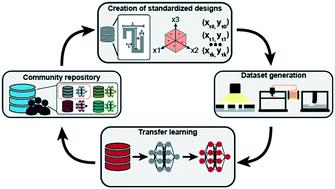Our official English website, www.x-mol.net, welcomes your feedback! (Note: you will need to create a separate account there.)
Machine learning for microfluidic design and control
Lab on a Chip ( IF 6.1 ) Pub Date : 2022-07-29 , DOI: 10.1039/d2lc00254j David McIntyre 1, 2 , Ali Lashkaripour 3, 4 , Polly Fordyce 3, 4, 5 , Douglas Densmore 2, 6
Lab on a Chip ( IF 6.1 ) Pub Date : 2022-07-29 , DOI: 10.1039/d2lc00254j David McIntyre 1, 2 , Ali Lashkaripour 3, 4 , Polly Fordyce 3, 4, 5 , Douglas Densmore 2, 6
Affiliation

|
Microfluidics has developed into a mature field with applications across science and engineering, having particular commercial success in molecular diagnostics, next-generation sequencing, and bench-top analysis. Despite its ubiquity, the complexity of designing and controlling custom microfluidic devices present major barriers to adoption, requiring intuitive knowledge gained from years of experience. If these barriers were overcome, microfluidics could miniaturize biological and chemical research for non-experts through fully-automated platform development and operation. The intuition of microfluidic experts can be captured through machine learning, where complex statistical models are trained for pattern recognition and subsequently used for event prediction. Integration of machine learning with microfluidics could significantly expand its adoption and impact. Here, we present the current state of machine learning for the design and control of microfluidic devices, its possible applications, and current limitations.
中文翻译:

用于微流体设计和控制的机器学习
微流控已发展成为一个成熟的领域,在科学和工程领域都有广泛的应用,在分子诊断、下一代测序和台式分析方面取得了特别的商业成功。尽管其无处不在,但设计和控制定制微流体设备的复杂性给采用带来了主要障碍,需要从多年的经验中获得直观的知识。如果这些障碍被克服,微流体可以通过全自动平台开发和操作,使非专家的生物和化学研究小型化。微流体专家的直觉可以通过机器学习来捕捉,其中复杂的统计模型经过训练以进行模式识别,然后用于事件预测。机器学习与微流体的集成可以显着扩大其采用和影响。在这里,我们介绍了微流体设备设计和控制的机器学习的现状、其可能的应用和当前的局限性。
更新日期:2022-07-29
中文翻译:

用于微流体设计和控制的机器学习
微流控已发展成为一个成熟的领域,在科学和工程领域都有广泛的应用,在分子诊断、下一代测序和台式分析方面取得了特别的商业成功。尽管其无处不在,但设计和控制定制微流体设备的复杂性给采用带来了主要障碍,需要从多年的经验中获得直观的知识。如果这些障碍被克服,微流体可以通过全自动平台开发和操作,使非专家的生物和化学研究小型化。微流体专家的直觉可以通过机器学习来捕捉,其中复杂的统计模型经过训练以进行模式识别,然后用于事件预测。机器学习与微流体的集成可以显着扩大其采用和影响。在这里,我们介绍了微流体设备设计和控制的机器学习的现状、其可能的应用和当前的局限性。

























 京公网安备 11010802027423号
京公网安备 11010802027423号